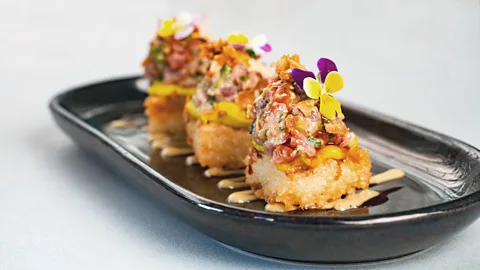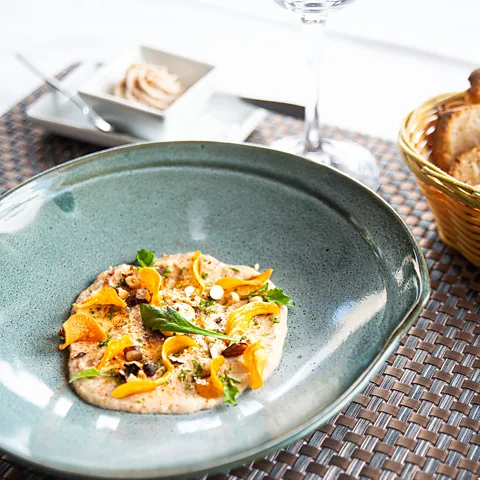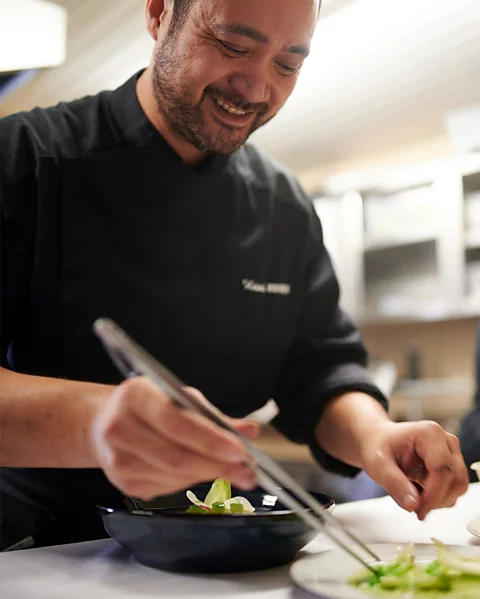How the Islands of Tahiti are reclaiming their cuisine
 ChefsdeTahiti
ChefsdeTahitiFrench Polynesia continues to feel an outsize influence from . But recently, Tahitians have been reclaiming their heritage, putting traditional ingredients on the menu.
Foie gras. Escargots. Steak frites. Visit French Polynesia and you'd be forgiven for forgetting that you're in the middle of the Pacific Ocean, nearly 26,000km away from Paris. An overseas country of , the Islands of Tahiti, as French Polynesia is sometimes known, continue to feel an outsize influence from abroad. Even the price of baguettes is controlled by the government, set to roughly 50 Pacific francs.
But in recent years, young Tahitians have been reclaiming their heritage, putting traditional ingredients like lagoon fish, taro leaf and star apple on the menu, and making them more accessible to their community – as well as tourists.
One such person is Heimata Hall, Moorea-born chef and the founder of Tahiti Food Tours. After spending five years in Honolulu working with the now-closed Town restaurant's Ed Kenney, a leader of the Polynesian farm-to-table food movement, Hall returned to his community with a similar "local first" ethos. He wanted to show travellers bite-by-bite how his homeland's bounty has more to offer than imported duck confit and how it bears the mark of two other prominent cultures: Native Tahitians and the Chinese who, brought here to work on coffee and sugar plantations in the 1860s, now make up the third largest population on the islands.
"A lot of times when people come to Tahiti, they get stuck going to the same mainstream restaurants," said Hall. "We went stagnant for a while, and it was really French cuisine that took the upper hand. I realised, 'Man, there's all these other little [Tahitian] mom-and-pop snack shops where we as locals eat, and tourists aren't tapping into that.' These places use incredibly diverse ingredients, especially from the sea. Most visitors don't even know that they exist."
On a typical afternoon with Hall, you might stop on the side of the road to buy ripe soursop or some crunchy mango with plum powder, as sweet as it is tart. Next, it's on to a roulotte (food truck) or snack (a casual canteen best known for big portions and small prices) for lunch, where you can order a Tahitian or Chinese fusion meal like poisson cru (recently caught, raw parrot fish with creamy, rich coconut milk), ma'a tinito (fatty pork belly with starchy red beans and vermicelli), or – a crowd favourite – chow mein sandwich (exactly what it sounds like, yet more delicious than you could ever imagine).
 ChefsdeTahiti
ChefsdeTahitiAccording to Hall, these modest, "quick service" spots, including Snack Rotui and Snack Mahana, are gradually becoming easier to find, thanks to their good value, high quality and a demand for authenticity from residents and tourists alike.
Alexandrine Wan, Tahiti-born CEO of French Polynesia tour company Nani Travels, has also discovered a rise in guests looking for meaningful travel. When it comes to Tahitian dishes, she said, "It's always a matter of ing to respect what you're eating. We work closely with the land and the ocean to get our food." Don't be surprised if the prawns you're dining on were plucked from the water a couple hours ago or that your mango is fresh off a tree.
Cooking on the Islands of Tahiti is an equally thoughtful process. Two of the most beloved Tahitian dishes, fafaru (a notoriously pungent fermented fish eaten with fermented coconut) and ahima'a (a cooking method named after the ground oven used to slow bake everything from wild pig to chicken) require little more than patience and time.
While celebrating the land and returning to Tahiti's roots has become part of the country's culinary present, many of its youngest chefs are imagining how they can carry these traditions into the future. Hall first recalls noticing this movement at Teao Maiarii's Maru Maru, a fine dining restaurant in the capital of Papeete that pays tribute to Tahiti's deep terroir.
 ChefsdeTahiti
ChefsdeTahiti"My first time eating there, I felt like I was reliving my childhood," said Hall. "It became emotional to see him cook with these local flavours and ingredients in a new, gastronomic way. Teao made a gnocchi-style breadfruit with a fish called oeo [trumpet emperor] that you usually don't see on the menu, because we're using tuna for everything now. He served super thin slices of uto [coconut sponge] with another fish, ouma, that I used to catch with my grandpa. I thought, 'This guy gets it.' It brought back so many good memories. What is Tahitian food today? It's taking ownership, finally, of our cuisine, our culture, our identity, and not having somebody else represent us anymore."
Maru Maru isn't the only restaurant at the intersection of home cooking and creative fusion. Heiarii Hoiore of Hei and Kirahu Chavez of Kozy are just two other local chefs who have discovered success through this evolving vision of Tahitian cuisine.
"I think it's very important to put our Polynesian cuisine and products forward, making them more accessible," said Chavez. "Kozy was opened with a very specific idea – to serve fresh local products such as breadfruit, mountain plantain, sweet potato, fish, local freshwater prawns and taro root, with French cooking skills to enhance them." At Kozy, Chavez fuses and builds off the islands' three major cultures with dishes like taro root risotto and ava ava ("sour" in Tahitian) raw fish that recalls her childhood spent in the Tuamotu archipelago. "It's a very tangy tuna-based dish seasoned with a secret sauce, ginger and mint that I gave a twist to."
 Hei
HeiMeanwhile, at Hei, guests settle in for a decadent prix fixe meal featuring courses like candied pineapple with honey and Tahitian vanilla and a fillet crusted in panko and breadfruit. Currently, Hoiore is dreaming of how he can feasibly add an ahima'a to the restaurant for Sunday dinners.
Chavez, Hoiore and many other chefs from this generation have another thing in common: a large percentage attended culinary school and worked at top restaurants in (a tempting proposition when you hold a French port). Now, more than ever before, ambitious young Tahitian chefs – perhaps empowered by those who came before – are putting in their hours training in prestigious kitchens halfway around the world, planning to return with contemporary techniques and knowledge to open their own restaurants.
